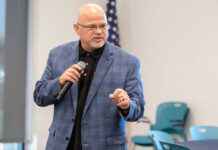National Volunteer Month in April celebrates the impact volunteers have on our lives and encourages active volunteerism for generations to come.
An extension of National Volunteer Week, the recognition was first made in 1943 to pay tribute to the unwavering contributions of women during World War II who collected supplies and helped wounded soldiers.
It was in the early 20th century that organized volunteering reached its peak. Numerous groups were created to escalate humanitarian services, many of which are still active today, such as the Red Cross.
In 1990, the week-long observation was lengthened to National Volunteer Month to be celebrated every April.
With a total of 1.8 million non-profit organizations in the United States alone, the opportunity to volunteer is close to never-ending. In fact, Americans volunteer 8.8 billion hours annually, the Urban Institute says.
Volunteering, putting empathy into action, can build stronger, more connected communities where people feel happier, healthier and more welcome.
There are mutual benefits to volunteering.
Giving to others can help protect your mental and physical health. It can reduce stress, combat depression, and provide mental stimulation and a sense of purpose. Volunteers find their efforts lead to a natural sense of accomplishment and added zest to life.
In every community, volunteer opportunities are available. The key is to find a position that you would enjoy and are capable of doing. Think about why you want to volunteer. What would you enjoy doing? The opportunities that match both your goals and your interests are most likely to be fun and fulfilling.
This content was first published in the April edition of InMaricopa magazine.














![Elena Trails releases home renderings An image of one of 56 elevation renderings submitted to Maricopa's planning department for the Elena Trails subdivison. The developer plans to construct 14 different floor plans, with four elevation styles per plan. [City of Maricopa]](https://www.inmaricopa.com/wp-content/uploads/2024/04/city-041724-elena-trails-rendering-100x70.jpg)

![Affordable apartments planned near ‘Restaurant Row’ A blue square highlights the area of the proposed affordable housing development and "Restaurant Row" sitting south of city hall and the Maricopa Police Department. Preliminary architectural drawings were not yet available. [City of Maricopa]](https://www.inmaricopa.com/wp-content/uploads/2024/04/041724-affordable-housing-project-restaurant-row-100x70.jpg)